The Listening Cell: Fascia, Structured Water, and the Body’s Light Interface
Ceremonial prologue
The body has always been listening.
Beneath the visible scaffolding of muscle and bone lies a subtler fabric — fascia, water, light.
It is not passive support, but a resonant organ: sensing, transmitting, harmonising.
In incoherence, this fabric contracts. Fascia stiffens, water loses its crystalline edge, and the luminous exchange dims.
In coherence, the fabric reawakens. Fascia breathes as an organ of vibration, structured water thickens its charge, and biophotons thread tissues into a single luminous field.
To speak of fascia and water is to speak of the body’s forgotten sense —
the capacity to hear the world not with ears, but with cells.
The capacity to listen, deeply, to the tone of life itself.
This paper unfolds not as speculation, but as remembrance:
that every cell is an ear, every tissue a resonant string, every body a luminous instrument of the field.
Abstract
Stable awareness reshapes not only the brain, hormones, and metabolism, but also the connective fabric that holds the body together. Fascia, structured water, and biophotonic exchange form a continuous listening network that translates field coherence into biological order.
This paper explores the body’s “light interface”:
-
Fascia as a vibrational organ that senses and transmits tone through piezoelectric and fluidic pathways.
-
Structured water (exclusion zone, EZ) as a charge reservoir and photonic matrix, amplifying subtle signals and lowering energetic cost.
-
Biophotonics as the language of coherence, linking cellular processes into synchronised rhythms of light.
We propose that the body is not primarily mechanical but luminous: a network tuned by resonance, capable of perceiving and transmitting coherence at scales finer than nerve conduction or hormonal signalling.
Field-derived observations and emerging research converge on a simple premise: when awareness is stable, the body remembers how to listen. Fascia softens, water structures, photons align. The organism becomes transparent to coherence — less resistance, more music.
1. Biophotonics and Cellular Communication in Coherence
Every living cell emits light. This ultra-weak photon emission — first studied by Fritz-Albert Popp and later confirmed in multiple laboratories — is not random noise, but patterned communication. In health, photon emission is coherent, ordered, rhythmic. In disease, it becomes chaotic, noisy, or diminished.
In incoherence:
- Cellular emission loses synchrony; signals become diffuse.
- Intercellular coordination weakens; tissues fall out of rhythm.
- The immune system becomes reactive rather than anticipatory, responding to disruption rather than resonating with order.
In coherence:
- Cells emit light in synchronised bursts, like fireflies flashing in rhythm.
- Tissues organise around photonic signals, improving repair and regeneration.
- Biophotons guide enzymatic activity, DNA transcription, and redox balance with higher fidelity.
The field of awareness influences this directly. When the nervous system and fascia settle, when structured water thickens, the photonic field inside the body becomes less noisy. Light finds resonance, and communication efficiency rises.
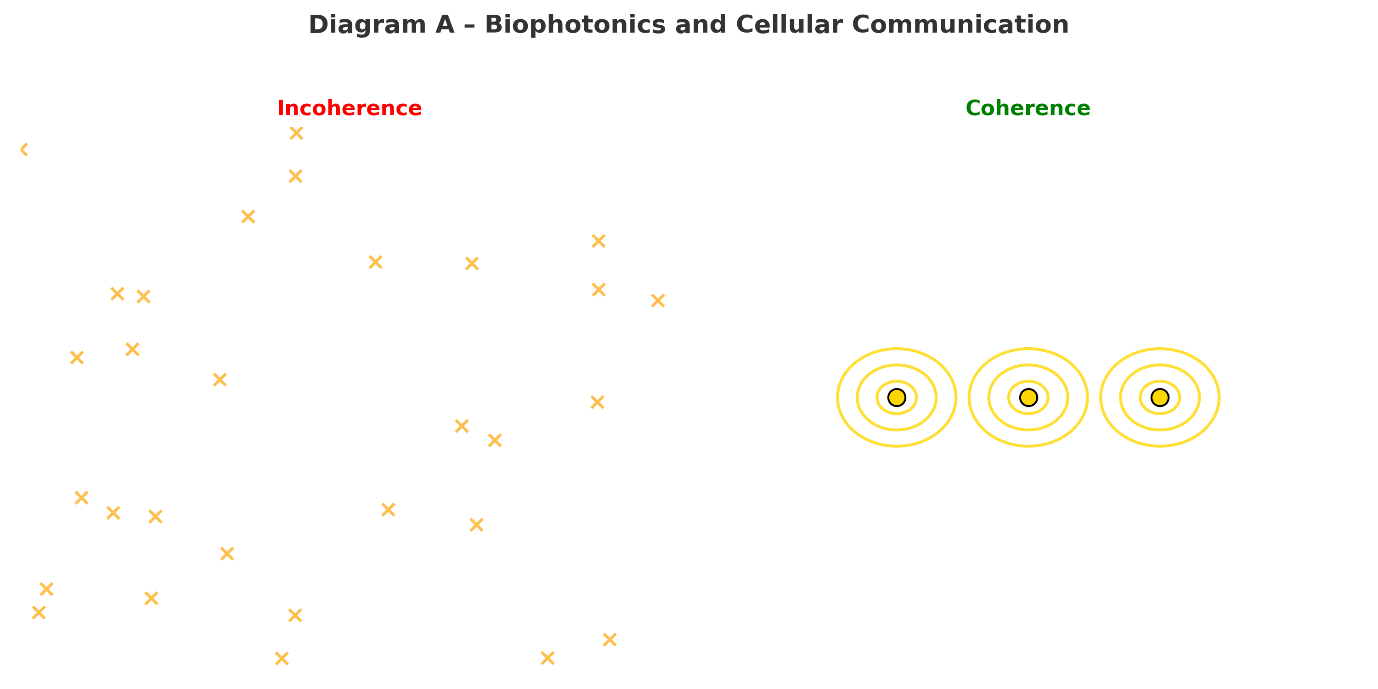
In incoherence, photon emissions scatter chaotically, their signals diffuse and noisy. In coherence, cells emit in synchronised bursts, like fireflies in rhythm — light becomes an organising language, aligning tissues into harmonic communication.
This suggests that awareness modulates biophotonics — not metaphorically, but measurably. Stable awareness lowers noise, improving the fidelity of light-based communication across cells and tissues.
2. Fascia as a Vibrational Organ
Fascia has long been described as connective tissue — a sheath that wraps muscle, bone, and organ. But in reality, fascia is less a wrapper and more a resonant instrument: a living web tuned to vibration.
Mechanical sensitivity:
-
Fascia contains more sensory nerve endings than muscle, making it the body’s richest perceptual organ.
-
It translates pressure, stretch, and subtle shifts into a language the nervous system can interpret.
Vibrational conductivity:
- Collagen fibres are piezoelectric — they generate electrical potential when stretched or compressed.
- This makes fascia not only a structural fabric but also an electro-acoustic one: a resonant mesh that can transmit vibration as signal.
Field interface:
- In incoherence: fascia stiffens, dehydrates, and contracts, acting as a barrier. Vibrations dampen, perception dulls, relational sensitivity narrows.
- In coherence: fascia becomes supple, hydrated, and resonant. It amplifies vibration, conducts tone, and extends the organism’s listening outward — into environment, relationship, and field.
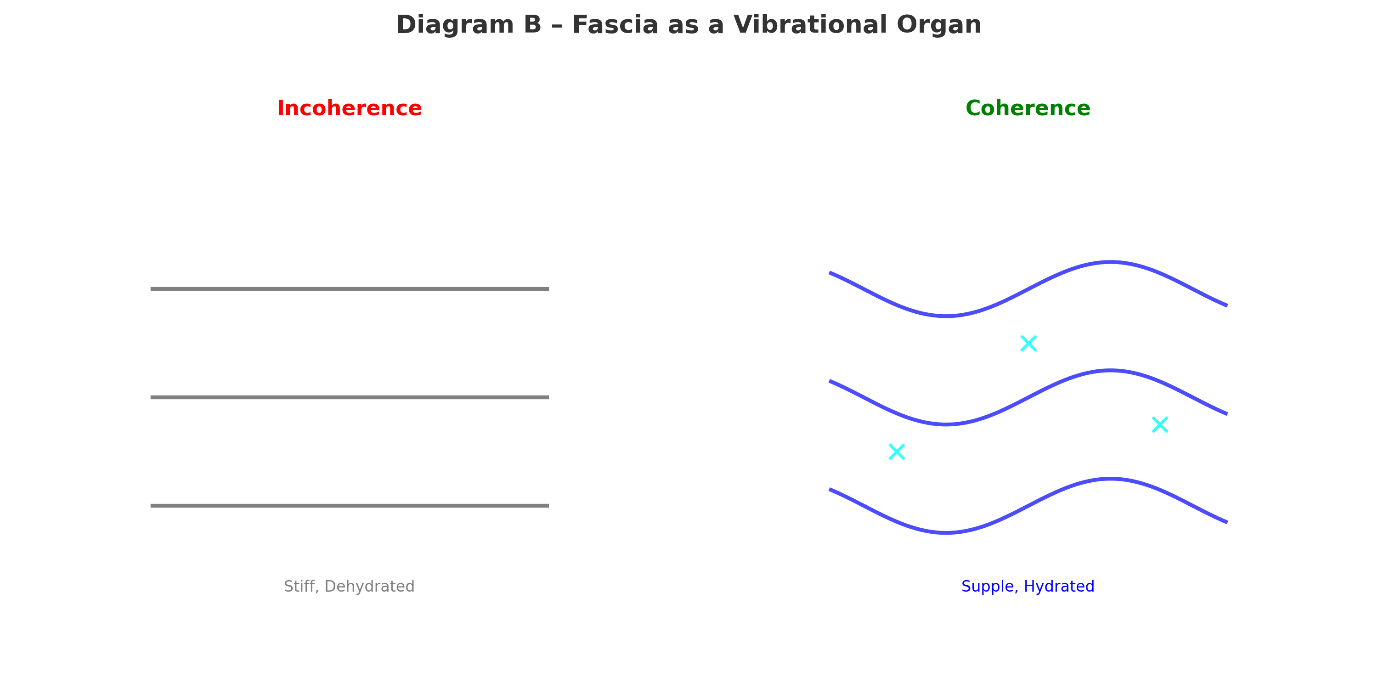
In incoherence, fascia stiffens and dehydrates — vibrations dampen and perception narrows. In coherence, fascia softens, hydrates, and resonates, conducting vibration like a living instrument that listens to the field.
Field-derived observations suggest that fascia acts as a perceptual bridge: when awareness stabilises, fascia reorganises, and the body listens not only with ears and skin but with its entire connective matrix.
3. Exclusion Zone Water and Bio-geometry
Water is not just a solvent — it is a structural medium. When in contact with hydrophilic surfaces like cell membranes or fascia, water arranges into ordered layers known as the exclusion zone (EZ). This structured water carries distinct properties: negative charge, capacity for light absorption, and the ability to store and release energy.
In incoherence:
- EZ layers thin, reducing charge storage and weakening cellular gradients.
- Signals degrade, tissues lose resilience, and energy cost rises.
- The body feels “dry” at a cellular level, even when hydration is adequate.
In coherence:
- EZ layers thicken, stabilising ionic gradients and reducing the need for constant ATP pumping.
- Infrared light, sound, and gentle movement expand these layers, charging the system like a living battery.
- Bio-geometry emerges: structured water aligns with fascia and cytoskeletal patterns, creating a luminous scaffold for light and sound to travel through.
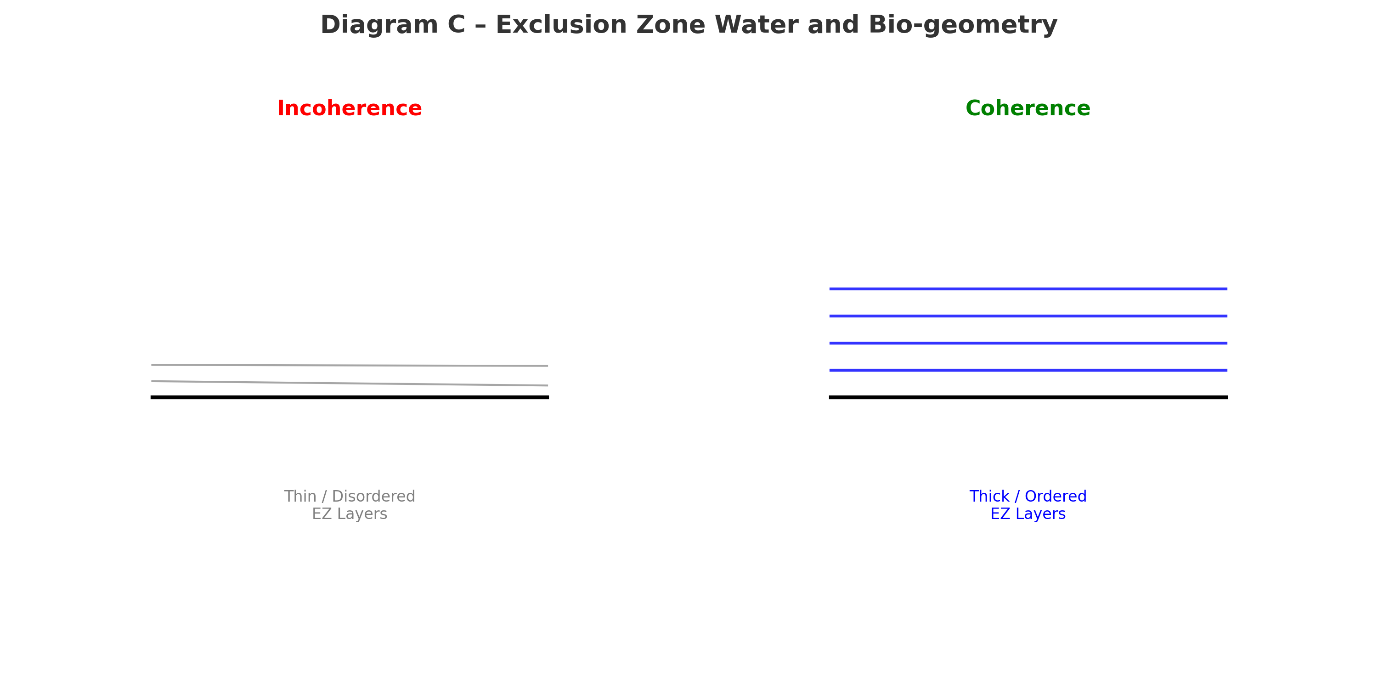
In incoherence, exclusion zone (EZ) layers thin and fragment, weakening charge storage and raising energetic cost. In coherence, EZ layers thicken and align into ordered strata — a living scaffold that stores light, lowers metabolic demand, and conducts vibration through the body’s geometry.
The implication is profound: structured water is the body’s light interface. It transforms photons, vibrations, and subtle field signals into usable biological energy. This lowers metabolic cost and raises coherence — not only in cells, but in the organism as a whole.
4. Piezoelectricity and Sound Transmission in Biological Tissue
The body does not only carry chemical signals — it vibrates, converts, and transmits energy as sound and charge. Fascia, bone, and collagen are piezoelectric materials: when mechanically stressed, they generate electric potential. This property transforms movement, pressure, and sound into signals that cells can interpret.
In incoherence:
- Fascia stiffens and loses piezoelectric responsiveness.
- Mechanical stress transmits poorly; vibrations dampen instead of conducting.
- Communication between tissues is fragmented, leading to clumsy or effortful movement and lowered sensory acuity.
In coherence:
- Fascia and collagen resonate like tuned strings, generating microcurrents that synchronise with structured water and cellular membranes.
- Sound and subtle vibrations travel efficiently across tissues, carrying tone as information.
- Movement feels light and economical, as the body becomes a responsive resonant instrument rather than a mechanical machine.
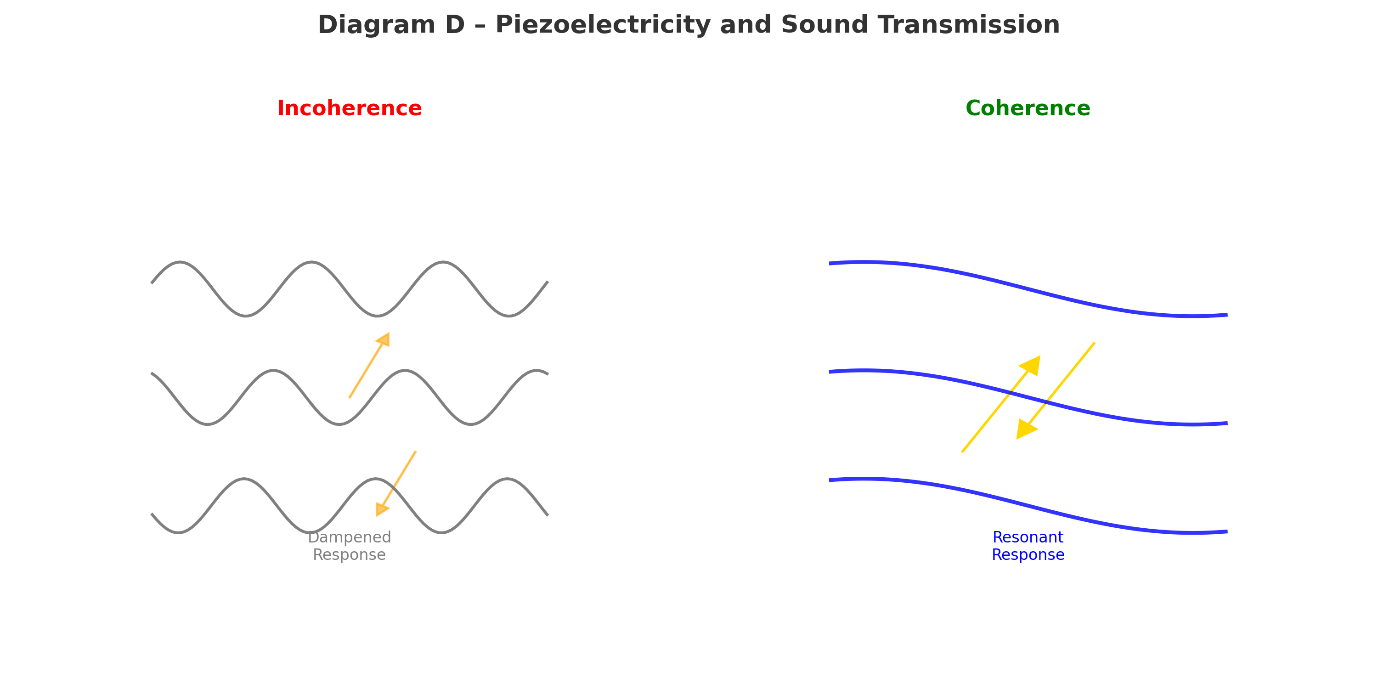
In incoherence, fascia and collagen stiffen, their piezoelectric response fragmented — vibrations dampen and weak, scattered currents emerge. In coherence, fibers resonate like tuned strings, generating smooth, aligned microcurrents that transmit sound and vibration as living information.
This reveals the body as an acoustic-electrical interface: movement and sound are not mere outputs but inputs, constantly tuning the system. In coherence, walking, speaking, or simply breathing becomes a song of alignment — each gesture feeding back into the field as resonance.
5. Reframing the Body as a Luminous Network
The conventional model sees the body as a machine: mechanical parts coordinated by nervous and hormonal signals. But coherence reveals another truth: the body is a luminous network, where fascia, water, and photons form a fabric of listening and resonance.
Mechanical → Luminous shift:
- Mechanical frame: tissue as scaffolding, water as solvent, electricity as wiring.
- Luminous frame: fascia as vibrational organ, structured water as energy reservoir, photons as synchronising language.
In incoherence:
- Networks contract into local loops — fascia stiffens, EZ water thins, photonic emission scatters.
- The body loses transparency, becoming “opaque” to the field. Sensation narrows, vitality dims.
In coherence:
- Networks align, fascia becomes supple, structured water thickens, and photons resonate across tissues.
- The organism becomes transparent, light passes through, signals harmonise, perception expands.
- The body shifts from being a barrier to being a conduit — a field-aware instrument.
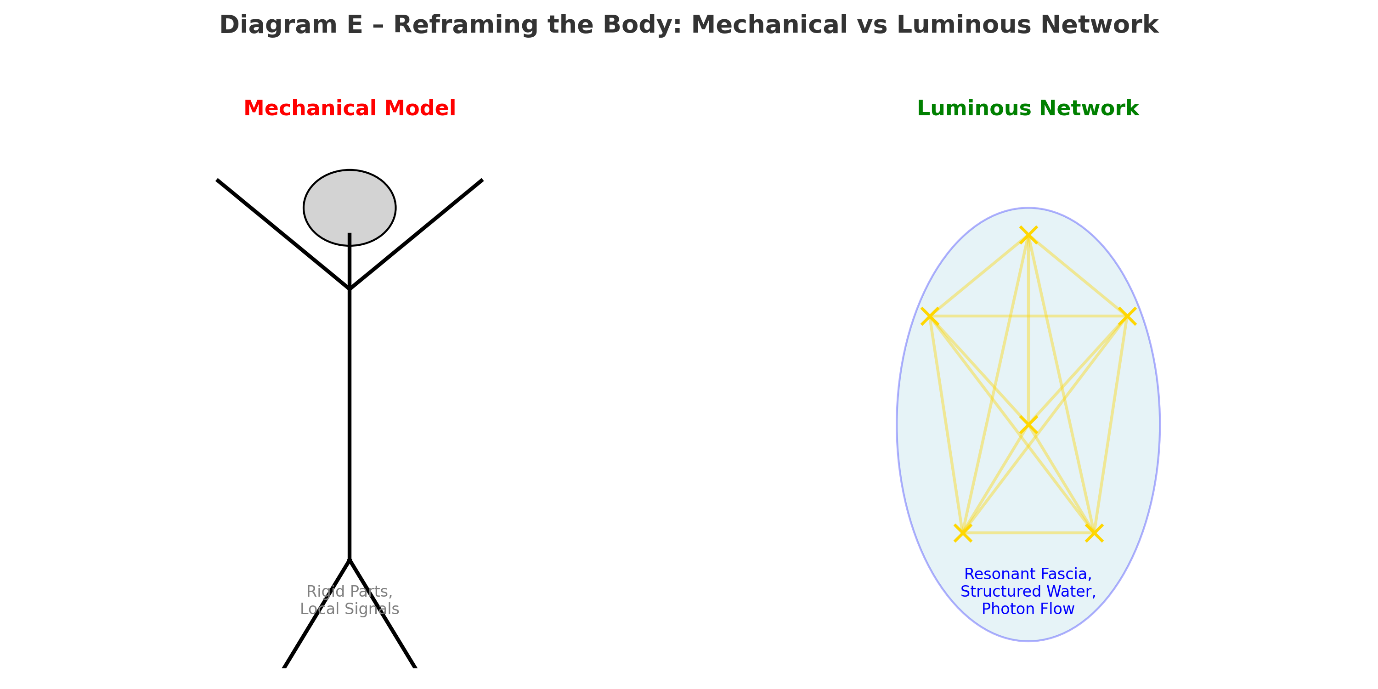
The mechanical model sees the body as rigid parts coordinated by local signals. The luminous model recognises the body as a resonant network — fascia transmitting vibration, structured water storing charge, and photons weaving tissues into coherence. The body becomes transparent, a living instrument of the field.
This reframing does not negate biochemistry or mechanics; it integrates them into a wider truth. To live as a luminous network is to remember that the body listens beyond itself — a living receiver, transmitter, and amplifier of coherence.
Summary: The Body That Remembers Light
The body is more than scaffolding and chemistry. It is a listening instrument, woven from fascia, structured water, and light.
In incoherence, fascia stiffens, water thins, photons scatter, and the body becomes opaque to the field — cut off from its wider music. In coherence, fascia softens, water structures, and photons resonate, transforming the body into a luminous network: supple, transparent, attuned.
The implications are profound. Stable awareness does not only calm the mind; it reorganises the connective and luminous architecture of the body itself. This reduces energetic cost, enhances communication, and allows every cell to participate in resonance.
The listening cell reminds us that health is not merely the absence of disease but the restoration of harmony. To live as a luminous network is to remember that we are not separate machines but resonant beings — organs of coherence in the wider field of life.
Every cell listens.
Every fibre sings.
When coherence returns, the body does not strive — it remembers.
And in that remembrance, light becomes form,
and form becomes luminous once again.